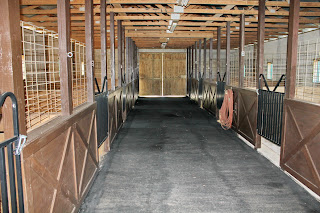Oh, my goodness! We bought a farm! Hubby finally got his orders after waiting 5 1/2 months. This left us with only two months to find a house, close on the purchase and move. Whew! Last week we jumped in the car and drove the seven hours up to Virginia to spend two days looking at houses in Virginia and North Carolina. On day one we looked at seven houses and the first six were utter disappointments (a disgusting double-wide, a modular that reeked of dog urine and sat across from a school that looked like it was in a horror film, one that needed to be completely gutted, and one that was next door to a commercial chicken warehouse). We were extremely discouraged driving to the last house. As soon as we drove up, however, we fell in love.
Nothing on day two even came close (one was partially swamp, one had standing water and car parts on the cleared section, another needed to be completely gutted, and one might have been okay, but needed too much land cleared) so we returned once again to this house for more pictures and a better look.

The house sits on a fairly busy two-lane road, but since there are no stoplights or signs nearby, we at least won't have to deal with revving engines. We are completely out in the country and considered agricultural. The previous owners operated a horse boarding business and bred Arabians and Paint horses. What does that mean? It already has a stable, fenced pastures and round pen! Oh, and did I mention that we included the farm equipment in the purchase? Yep! We are the proud owners of a riding mower, real tractor with front loader, bush hog, manure spreader (we renamed it the poo flinger), cultivator and fertilizer spreader. We aren't sure, but the owners may decide to leave various other pieces that hook onto the mower.

This is a side-view of the garage and stable. The garage is currently home to the workshop and is storage for the riding mowers. It also has an office where the window is. We will convert the right side into a man-cave for hubby, leave the office where it's at, and turn the rest into Grandpa's workshop. Towards the back of the stable you can see what's either the bedding storage or manure storage.
This is the round pen that sits towards the front of the property. Various fruit trees line the road and run between the round pen and the house. We will have peach, cherry, Granny Smith apple, plum, and pecan. We may leave the round pen as it is, or remove it and put in an arena instead.
This is a run-in for the horses, but since that area of the property isn't fenced, we won't use it for the horses. Our garden is going to extend probably from the edge of the garage/stable to the opposite property line. This building, then, will be turned into either a garden shed or a chicken coop. We plan to have at least a dozen chickens and their coop and rotating runs would be perfect in this space.
This is the inside of the stable. It has five stalls on the left side and four on the right. It also includes a utility room with water heater, utility sink and plenty of storage space, a separate tack room, and a wash stall with hot water. Each stall has one corner feeder already installed and we'll add a water bucket.
This is the back view of the stable which is completely fenced. You can see the small gate on this end and there's a large equipment gate on the left side by the stable wall. We may use this as a holding pen, but I'm not sure yet. It's currently home to some farm equipment which would have to find a new home if the horses were in there. I may also eventually knock out the walls on this side and make indoor-outdoor runs for a few stalls.
This is the equipment shed that holds the tractor and attachments. We'll probably store the hay inside as well and we may use a small section as a milking parlor for the cow. I'm thinking the cow might be able to use the left side of that fenced area and some of the adjoining pasture. The woods to the left belong to us and has a creek running through the back section. We'll leave that area alone and just enjoy the beauty of it.
The property behind us and the one to the right side of us are both for sale. I'm going to ask both of them if they would consider selling us a small piece of their land for us to extend our pastures. The one to the right is currently being used as farm land, so that would be ideal. The land behind us is wooded and that would mean lots of clearing and land prep.
Hubby's mom and step-dad are moving in with us and will be building their own
small tiny house. She's a Master Gardener and he's handy with pretty much anything. Between the two of them, they already have a wealth of experience and knowledge. They owned almost eight acres in Kansas for several years before selling and spending the last year-and-a-half on the road in a travel trailer. They enjoy being on the road, but are looking forward to sleeping in a real bed and enjoying their hobbies again.








